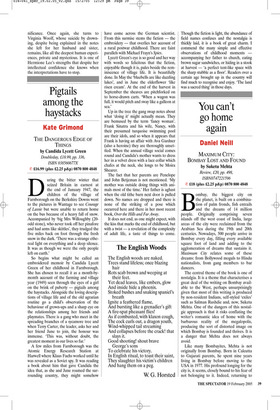Pigtails among the haystacks
Kate Grimond
THE DANGEROUS EDGE OF THINGS by Candida Lycett Green Doubleday, £18.99, pp. 336, ISBN 038560677X ✆ £16.99 (plus £2.25 p&p) 0870 800 4848 During the bitter winter that seized Britain in earnest at the end of January 1947, the children of the village of Farnborough on the Berkshire Downs went to the pictures in Wantage to see Courage of Lassie but were unable to return home on the bus because of a heavy fall of snow. Accompanied by ‘big Mrs Willoughby (20odd stone), who never took off her pinafore and had arms like skittles’, they trudged the five miles back on foot through the fresh snow in the dark. ‘There was a strange ethereal light on everything and a deep silence. It was as though we were the only people left on earth.’ So begins what might be called an embroidered memoir by Candida Lycett Green of her childhood in Farnborough. She has chosen to recall it as a month-bymonth account of the farming and village year (1949) seen through the eyes of a girl on the brink of puberty — pigtails among the haystacks. Alongside the loving descriptions of village life and of the old agrarian routine go a child’s observation of the behaviour of grown-ups and a sharp eye on the relationships among her friends and playmates. There is a gang who meet in the spreading branches of a sycamore tree and when Terry Carter, the leader, asks her and her friend June to join, the honour was immense. ‘This was, without doubt, the greatest moment in our lives so far.’ A few miles from Farnborough was the Atomic Energy Research Station at Harwell where Klaus Fuchs worked until he was revealed as a Soviet spy. It was reading a book about him that gave Candida the idea that, as she and June roamed the surrounding country, they might somehow have come across the German scientist. From this surmise stems the fiction — the embroidery — that overlies her account of a rural postwar childhood. There are faint parallels with Michael Frayn’s Spies.
Lycett Green’s eye is so good and her way with words so felicitous that the fiction, enjoyable though it is, pales beside the reminiscence of village life. It is beautifully done. In May the ‘bluebells are like dazzling lakes’, and in June the elderflower ‘like risen cream’. At the end of the harvest in September the sheaves are pitchforked on to horse-drawn carts. ‘When a wagon was full, it would pitch and sway like a galleon at sea.’ Up in the tree the gang swap notes about what ‘doing it’ might actually mean. They are bemused by the term ‘fancy woman’. Frank Sinatra and his wife, Nancy, with their presumed turquoise swimming pool are their idols, and so when it appears that Frank is having an affair with Ava Gardner (also a heroine) they are thoroughly unsettled. When the annual village social comes round and Candida’s mother wants to dress her in a velvet dress with a lace collar which chafes at the neck, she longs to be Moira Shearer.
The fact that her parents are Penelope and John Betjeman is not mentioned. ‘My mother was outside doing things with animals most of the time.’ Her father is aghast when the old tithe barn next door is pulled down. No names are dropped and there is none of the striking of a pose which occurred here and there in her most recent book, Over the Hills and Far Away.
It does not end, as one might expect, with the kiss that marks the end of childhood, but with a twist — a revelation of the complexity of adult life, a taste of things to come.

















































 Previous page
Previous page